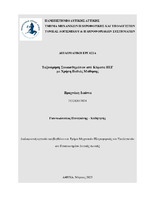| dc.contributor.advisor | Γιαννακόπουλος, Παναγιώτης | |
| dc.contributor.author | Βραχνάκη, Ιωάννα | |
| dc.date.accessioned | 2023-04-19T08:19:57Z | |
| dc.date.available | 2023-04-19T08:19:57Z | |
| dc.date.issued | 2023-03-02 | |
| dc.identifier.uri | https://polynoe.lib.uniwa.gr/xmlui/handle/11400/4249 | |
| dc.identifier.uri | http://dx.doi.org/10.26265/polynoe-4088 | |
| dc.description.abstract | Στην παρούσα διπλωματική εργασία υλοποιείται εφαρμογή, η οποία ταξινομεί τριών ειδών συναισθήματα από κύματα ΗΕΓ κάνοντας χρήση μεθόδων βαθιάς μάθησης. Οι μεθοδολογίες που χρησιμοποιήθηκαν ήταν του MLP, του Keras API, του LSTM, του GRU και του CNN κάνονταςάμεση σύγκριση προκειμένου να δειχθεί η βέλτιστη. Τα δεδομένα που επεξεργάσθηκαν ήταν εγκεφαλικά κύματα που πάρθηκαν από πείραμα στο οποίο οι συμμετέχοντες παρακολουθούσαν βίντεο, ενώ καταγραφόταν η συναισθηματική τους κατάσταση από ηλεκτροεγκεφαλογράφο. Τα συναισθήματα που προέκυψαν κατηγοριοποιούνται σε θετικά, αρνητικά και ουδέτερα. Το θεωρητικό υπόβαθρο αυτής της υλοποίησης υπογραμμίζει τρία κεφάλαια, όπου αναπτύσσονται: η αντίληψη συναισθημάτων, η νευροεπιστήμη της νόησης και τα δεδομένα με τη βαθιά μάθηση. Σε αυτά γίνεται επέκταση των εννοιών για τη νόηση, το συναίσθημα, το γνωσιακό προβληματισμό, τη νευροεπιστήμη, τον ηλεκτροεγκεφαλογράφο, τους τύπους, την ποιότητα και την προεπεξεργασία των δεδομένων, όπως και λίγα λόγια για τη μηχανική και τη βαθιάμάθηση. Τα υπόλοιπα κεφάλαια περιλαμβάνουν την εισαγωγή, την εφαρμογή που περιλαμβάνει την υλοποίηση καθώς και τα τελικά συμπεράσματα. Η επιλογή αυτού του θέματος ήταν έμπνευση από την λειτουργία του ανθρώπινου εγκεφάλου. Η δυνατότητα ανάγνωσης του ανθρώπινου νου μέσα από τη βαθιά μάθηση μπορεί να θεωρηθεί και τέχνη, καθώς ανοίγει νέους ορίζοντες για την ερμηνεία της λειτουργίας του εγκεφάλου, η οποία δεν έχει γίνει πλήρως κατανοητή μέχρι σήμερα. Η παρούσα εργασία ήταν μια πρόκληση για τις μεθόδους της βαθιάς μάθησης, όπως και μια ανακάλυψη για το που έχει φτάσει η τεχνολογία και πόσο ακόμα έχει να εξελιχθεί. | el |
| dc.format.extent | 78 | el |
| dc.language.iso | el | el |
| dc.publisher | Πανεπιστήμιο Δυτικής Αττικής | el |
| dc.rights | Αναφορά Δημιουργού - Μη Εμπορική Χρήση - Παρόμοια Διανομή 4.0 Διεθνές | * |
| dc.rights | Attribution-NonCommercial-NoDerivatives 4.0 Διεθνές | * |
| dc.rights | Attribution-NonCommercial-NoDerivatives 4.0 Διεθνές | * |
| dc.rights.uri | http://creativecommons.org/licenses/by-nc-nd/4.0/ | * |
| dc.subject | Νόηση | el |
| dc.subject | ΗΕΓ | el |
| dc.subject | Ταξινόμηση συναισθημάτων | el |
| dc.subject | Εγκεφαλικά κύματα | el |
| dc.subject | Βαθιά μάθηση | el |
| dc.title | Ταξινόμηση συναισθημάτων από κύματα ΗΕΓ με χρήση βαθιάς μάθησης | el |
| dc.title.alternative | Εmotions classification from EEG waves using deep learning | el |
| dc.type | Διπλωματική εργασία | el |
| dc.contributor.committee | Πρεζεράκος, Γεώργιος | |
| dc.contributor.committee | Βογιατζής, Ιωάννης | |
| dc.contributor.faculty | Σχολή Μηχανικών | el |
| dc.contributor.department | Τμήμα Μηχανικών Πληροφορικής και Υπολογιστών | el |
| dc.description.abstracttranslated | n this thesis an application is implemented, which classifies three types of emotions from EEG waves using deep learning methods. The methodologies used were of MLP, Keras API, LSTM, GRU and CNN making direct comparison in order to show the optimal one. The data processed were brain waves taken from an experiment in which participants watched videos while their emotional state was recorded by an electroencephalogram. The resulting emotions were categorized into positive, negative and neutral. The theoretical background of this implementation highlights three chapters, which develop: emotion perception, the neuroscience of cognition and data with deep learning. In these, the concepts of cognition, emotion, cognitive reflection, neuroscience, electroencephalography, data types, quality and preprocessing are expanded, as well as a few words about machineand deep learning. The remaining chapters include the introduction, the applicationincluding the implementation as well as the final conclusions. The choice of this topic was inspired by the functioning of the human brain. The ability to read the human mind through deep learning can also be considered an art, as it opens new horizons for the interpretation of brain function, which has not been fully understood to this day. This paper was a challenge to deep learning methods, as well as a discovery of where technology has come and how far it has yet to evolve. | el |


